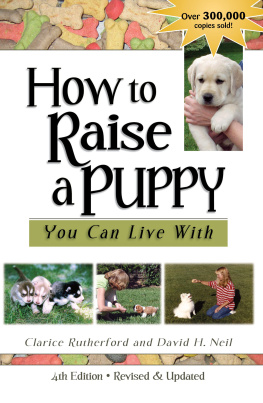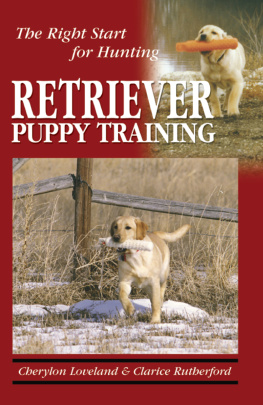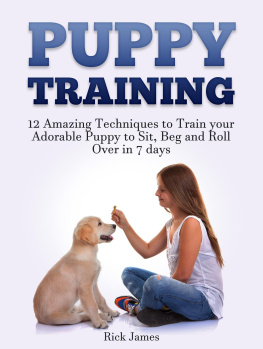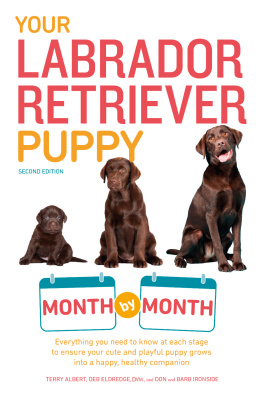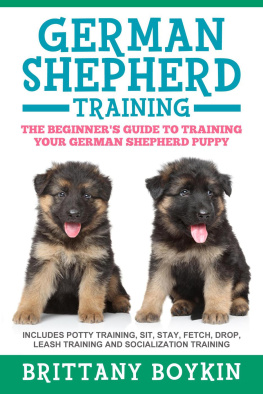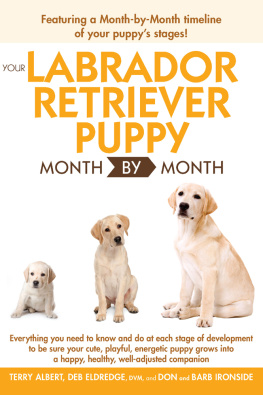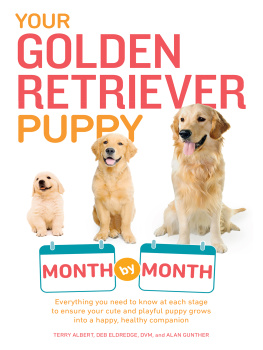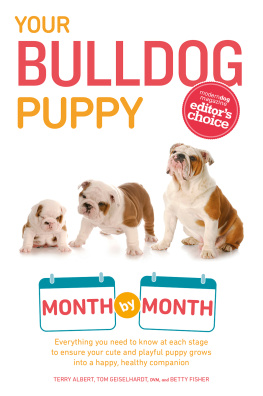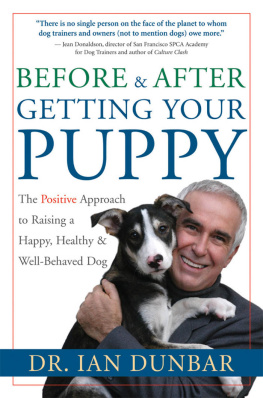HOW TO RAISE A PUPPY YOU CAN LIVE WITH 4th Edition
1981, 1992, 1999, 2005 by Clarice Rutherford and David H. Neil.
ISBN: 978-1-61781-244-6
Dogwise Publishing
403 South Mission Street, Wenatchee Washington 98801
1-800-776-2665
Bulk discounts available
All rights reserved. No part of this book may be reproduced or transmitted in any form or by any means, electronic, digital or mechanical, including photocopying, recording or by any information storage or retrieval system without permission in writing from the publisher.
Limits of Liability and Disclaimer of Warranty:
The author and publisher shall not be liable in the event of incidental or consequential damages in connection with, or arising out of, the furnishing, performance, or use of the instructions and suggestions contained in this book.
Copyediting: Deborah Helmers
Cover design and book layout: Kelly Hines Keller, GrafikNature Design
Cover photos: (top & bottom bands)Kelly Hines Keller, GrafikNature Design, (top right)Glenda Jackson, (bottom left)Hemera Technologies & its licensors, (bottom center) Meggin Rutherford, (bottom right)Joyce Wooley. Illustrations: Nancy Robinson, Julie Sorbie, and Terry Nash.
Printed in the United States of America
To All the Puppy People
Who Have Made a Choice...
A CONTRACT
I have chosen to share my life with you, a member of another species. I pledge to appreciate your uniqueness as a member of the canine family and to attempt to raise you and discipline you in terms of this uniqueness.
In return, I know that you will do your best to fit into my lifestyle if it is caninely possible, and will reciprocate my attention to you by letting me share your view of the universe.
I will be a better person for having this experience. I hope your life will be better for having lived with me.
CONTENTS
We wish to thank the people who have aided in the preparation of the fourth edition of this book: Barbara Fleming for organizing the new text, Elizabeth Stimmel for typing the complete text, Deborah Helmers for her patient and thorough editing, Kelly Hines Keller for graphic design, and Sue Henning for her continuing work on puppy temperament testing.
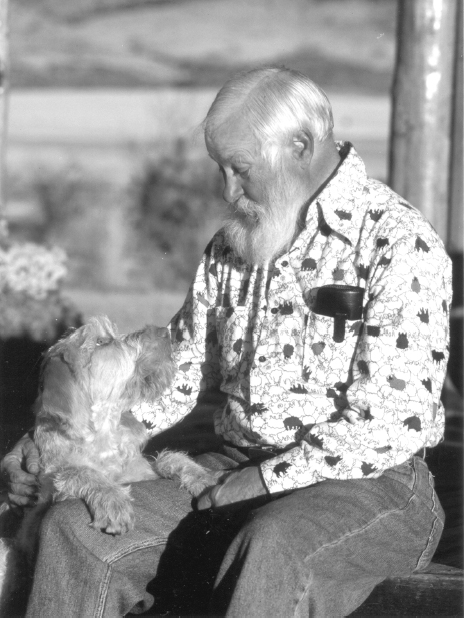
Photo by Judith Strom.
Every year, countless numbers of people develop relationships with their dogs in work and play, allowing subtle, effective two-way communication to be comfortably established. In some of these relationships, the bond continues to grow stronger, and what begins as a matter of expediency between two awkward strangersthe new owner and the new puppy dogbecomes, in the fullness of time, a meeting of minds and hearts.
At the dawn of civilization in the ancient city of Jericho, there were dogs as large as wolves and as small as terriers. Already man had selected and bred different types of dogs for different functions. This selecting and breeding has continued for thousands of years as a continuous process. Today approximately 200 breeds are recognized by the American Kennel Club, breeds which in one way or another enrich our lives in work and play. We see the amazing adaptation of various breeds to become seeing-eye and hearing-ear dogs. Dogs also assist the physically handicapped. No matter what functions dogs perform, the basic, underlying theme throughout the vast majority of them is companionship. Pet dogs in contemporary society continue to provide a focus of attention and affection for people who feel very much alone, whether confined to their homes or to an institutional setting.
If the status quo prevails, dog ownership is
going to get tougher, and deservedly so....
The way we play it may have very significant impact
on the future of the domestic dog in urban society.
Having praised dogs to the skies, however, we recognize that all is not well with the unwritten contract between man and dog. Too many dogs do not enjoy a healthy family situation and get into so much trouble that they are either impounded or relinquished to the animal shelter. A high percentage of these animals are approximately eighteen months old and, having outgrown their cuteness, are having behavioral problems that their owners could not deal with. Our purpose in writing this book is to help people understand their puppys behaviors and needs as he grows into maturity.
We believe that the first step toward getting a dog that you and everyone else can live withafter selecting the right breed for you, of courseis to find a good breeder who recognizes how important the first two months of a puppys life are in determining how he will be able to deal with the big world as a mature dog. When your carefully selected puppy comes home with you, you are now in the drivers seat, and your knowledge and patient actions will further determine whether you will soon own a dog that youand your communitycan live with.
One of the big issues involves raising a normal puppy when during the day the entire household is either out to work or at school. We have addressed this issue in the book. Recognizing that separation anxiety is a serious problem, we have addressed this both in terms of proofing the puppy against the development of separation anxiety as well as recognizing some of its signs and dealing with them when they start to occur in later months.

Look for the puppy with the personality that most closely fits your ideal. Observe the puppies as a group, but dont make a decision based on the pups behavior with the littermates. Take him away from the litter and evaluate his response to you as well. Photo by Judith Strom.
When you visit a litter of little puppies that are so easy to handle and control, it is easy to overlook the thought that within a few months these puppies will have the size and general behavioral characteristics of their breed, together with the individual behavioral tendencies inherited from the parents. Unfortunately, when you select one of the pups and take him home, you might be unhappy with the result, because that little puppy can change into a much larger and more vigorous dog than your home and life-style can manage. It isnt the pups fault if you didnt think about the adult dog that the puppy would become.
The best puppy for you is the one you can live with, and everyone else can, too. When choosing a puppy, you must be able to visualize what the adult dog will be like physically and behaviorally and how he will fit into your home facilities as well as into your life. For instance, a person who would be very content with a relatively slow-moving Basset would probably be frustrated with a quick-moving, high-energy terrier.
Perhaps the first deliberate action in acquiring a puppy is to set aside sufficient time to familiarize yourself with all that the world of dogs can offer you, and, in turn, what you can offer a dog. During this time, you can resort to the abundant literature on dogs and seek expert advice. In this way, you start to zero in on that special little chap that will so enrich your life in the future.
The best puppy for you is the one that will grow up
into the right dog for you. When choosing a puppy,
you must be able to visualize what the adult dog
will be like, physically and behaviorally.
Dont pick a breed on its looks alone you could be surprised.

